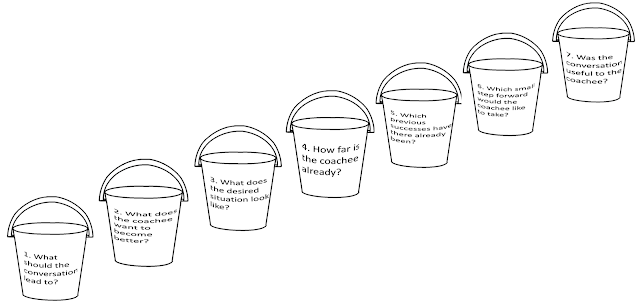Coaching as the filling of 7 buckets
Many progress-focused coaches are enthusiastic about our 7 steps approach. This approach reflects a conversation structure which often works quite well in coaching conversations. Years ago, a student told me she used this approach in her coaching conversations. At the end of the conversation she always would always ask whether coachees had found the conversation useful. Nearly always, theses coaches confirmed that the conversation had been useful, she said. But, she asked, it's very well that they found it useful but I am also engaged in my own learning process. How can I get a sense of whether I have done well in the conversation?
Filling 7 buckets
I replied that you can think of the conversation as a process of filling 7 buckets. These 7 buckets correspond to the 7 steps of our 7 steps model. Each time the coachee gives an answer that corresponds with one of the steps, that bucket becomes a bit fuller. Sometimes, you may just follow the 7 steps structure. That is straightforward. Often, however, the conversation will not proceed that linearly. Sometimes you are at step 3 and you'll need to go back to step 2. Or you are already at step 4 and you need to go back to step 2 or 3. It is important to realize that the order of the steps is not restrictive. Responding to what is important for your coachee is a more important guiding principle for what is on the table.
The sequence of bucket filling is not so important
When thinking about the conversation as a process of filling 7 buckets it may become more easy to get an idea of how effectively you have conducted the conversation. Your goal is to make sure that each of the buckets is fulled at the end of the conversation. It does not matter much when which bucket gets filled. I have once had a coachee who said at the beginning of the conversation, before having said anything else: "I now know what I have to do differently!" Instead of saying: "Not so fast! Let's first discuss how we can make this conversation useful for you", I thought: "Ah, that's interesting, he begins by filling bucket 6!" I continued to ask questions and thought: "We'll fill those other buckets as the conversation proceeds." And that is precisely what we did.
End of the conversation: all buckets filled
At the end of the conversation all buckets will be filled. You know what the coachee hopes to gain from the conversation (bucket 1), what the person would like to become better (bucket 2), what the desired situation looks like (bucket 3), how far the person already is on the way to that situation (bucket 4), when the desired situation has already happened to some extent and how the person made that possible (bucket 5), what small step(s) forward the person would like to take (bucket 6), and whether the conversation has been useful for the person (bucket 7).
One more remark: in the beginning you may find it hard to immediately know all the question from the 7 steps when you need them. If that is the case, by all means use a cheat sheet. Coachees usually don't mind at all and it can help to make your conversations much better.
One more remark: in the beginning you may find it hard to immediately know all the question from the 7 steps when you need them. If that is the case, by all means use a cheat sheet. Coachees usually don't mind at all and it can help to make your conversations much better.

Comments